I mentioned earlier this week about our beautiful Palo Verde tree that fell victim to the high winds of a monsoon storm. As sad as I was for the loss of my tree, I began to realize that I would now have to choose a replacement. Now I don’t know about you, but I just love it when I get to buy a new tree or plant. My husband is not usually as excited as I am because he is usually the one digging the holes 😉
Faced with the wonderful dilemma of having to choosing what type of tree to plant, I have began to go through the list of candidates – listing their positives and sometimes the negatives. In my last post, we looked at 12 different trees and today I would like to finish the list of prospective tree choices.
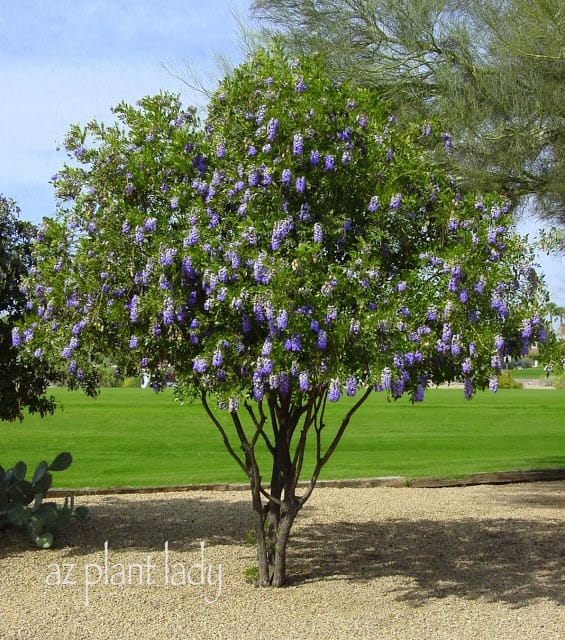
Texas Mountain Laurel (Sophora secundiflora)
I think it is the purple flowers that show up in the springtime that make this one of my favorite small trees. The flowers are not only beautiful, but they perfume the air with the fragrance of grape bubblegum.
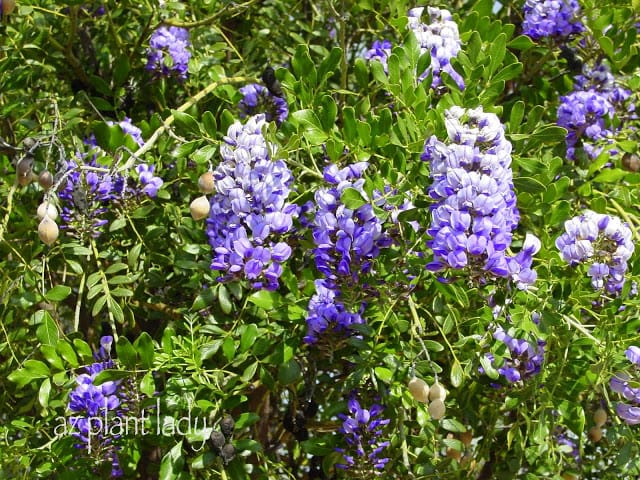
When not blooming, Texas Mountain Laurel makes an extremely attractive evergreen tree or large shrub, depending on how you prune (train) it. At maturity, it can reach heights of 15 – 25 ft. high and up to 15 ft. wide. I like how it grows in full sun as well as light shade. The fact that it is thornless is a bonus.
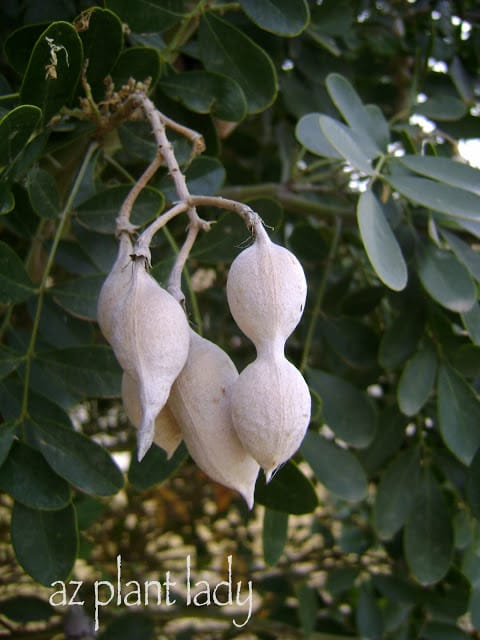
Most people I have spoken to are not generally fans of seedpods and try to stay away from trees that produce them. However, most do not mind the seedpods of the Texas Mountain Laurel, because they add an attractive element to the tree. The seedpods contain bright red seeds that are poisonous, but are extremely hard. As a result, experts say that the seeds would likely pass through the digestive tract, undigested.
*Caterpillars can become a problem during warm weather, but you can just ignore them and/or pick them off. If you see loose webbing on the leaves, that is a sign that it is infected by caterpillars. The damage caused from the caterpillars does not usually hurt the tree. It helps if you detect the eggs before they hatch and remove them. Since caterpillars usually infect the new growth, I just prune off the affected areas.
As much as I love this small tree, I will probably look for something that will grow a little taller.
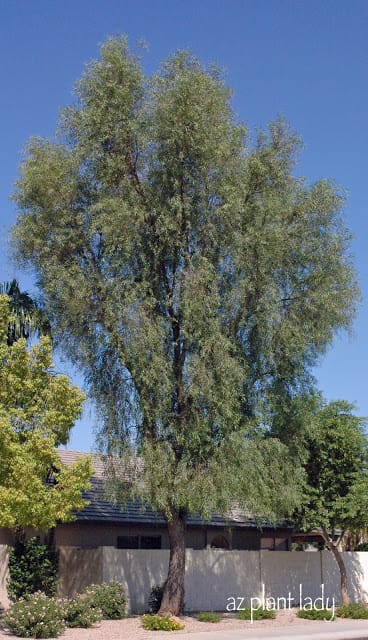
Willow Acacia (Acacia salicina)
Another of my favorite imports from Australia, Willow Acacia offers beauty in narrower spaces. I planted over 100 of these trees in golf courses. Their relative low maintenance, lack of thorns, and graceful willow-like growth habit makes this tree an asset in many areas. I also love that fact that they are evergreen. You can see them growing in common areas, entry and patio gardens as well as golf courses.
Their mature size of approximately 40 ft high and 20 ft. wide make this a great selection to use in a narrow space such as a side yard.
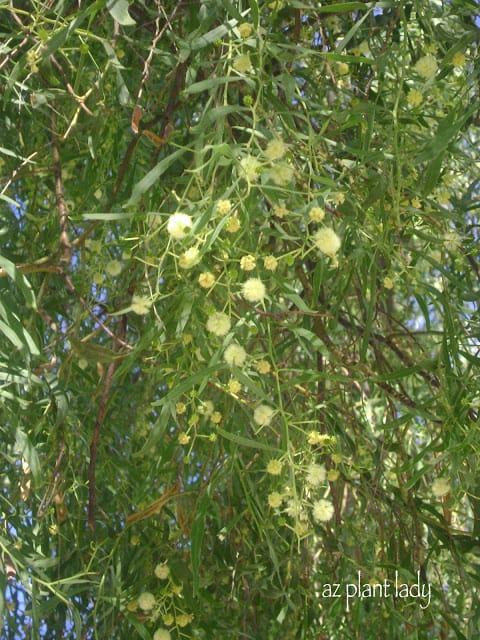
In late summer and fall, cream colored, puffball flowers appear which have a pleasing, light fragrance.
I may have to seriously consider planting a Willow Acacia….
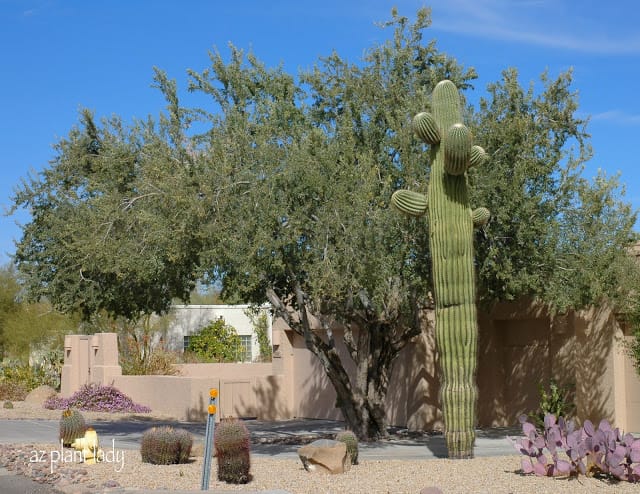
Ironwood (Olneya tesota)
A somewhat iconic desert tree is the Ironwood. Native to the southwestern deserts, this tree is characterized by gray-green foliage, and extremely hard wood. A slow growing tree, it can reach 30 ft. high and 25 ft. wide, although I have seen some specimens that are larger. Almost evergreen, it loses it’s leaves just before flowering in late winter, although severe drought can also cause it to lose it’s leaves.
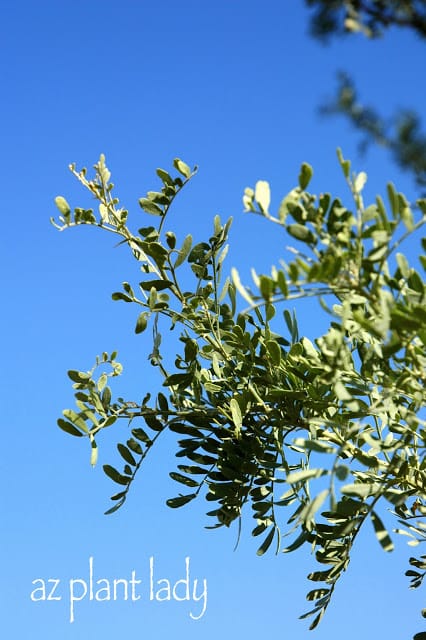
This beautiful tree does best in full sun and should be kept away from close proximity to pedestrian areas as the thorns can be troublesome. In late winter, their flowers begin to appear. The trees appear covered in a lavender mist. The flowers are small but are incredibly breathtaking up close…. but you can easily miss them, so pay attention.
Ironwood trees are often found growing on golf courses in our area. Usually, the golf course was built around certain specimen trees that were already present. Ironwood trees do not fare very well over time when planted in grassy areas. I have seen my share of stately Ironwood trees decline over time on golf courses until they had to be removed.
I do love this tree, but would like to keep away from having thorny trees in my back garden where my children play and would also like a tree that is somewhat faster growing. **I am normally a proponent of purchasing trees in smaller containers such as a 15- gallon tree instead of a 24″ box tree because once in the ground, the 15-gallon tree will rapidly catch up in size to the planted 24″ box tree. BUT when shopping for a tree that is known to be a slow-grower, then I do recommend buying the largest size you can afford.
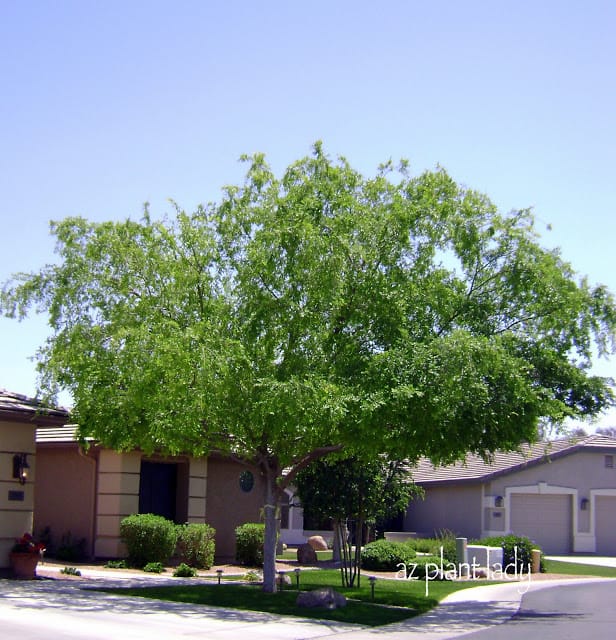
Evergreen Elm (Ulmus parvifolia)
Contrary to the common name, Evergreen Elm, this beautiful shade tree is NOT evergreen. *I would really love to talk to the people who come up with these common names 😉 If you want a large shade tree, then this is a great selection. Bright, light green leaves, smooth bark that chips off in the shape of puzzle pieces, thornless…..there is little not to love. It does drop it’s leaves in winter and they do not change into pretty autumn colors before falling off.
When deciding where to plant, make sure to allow plenty of room for the roots of this 35 ft. x 35 ft. tree. The dense shade it produces is a welcome respite from a hot, summer day. But the shade makes it difficult for summer grass to grow underneath as well as many plants.
Personally, I would like to try to find an evergreen tree for my garden that does not produce dense shade because I do like to plant underneath my trees.
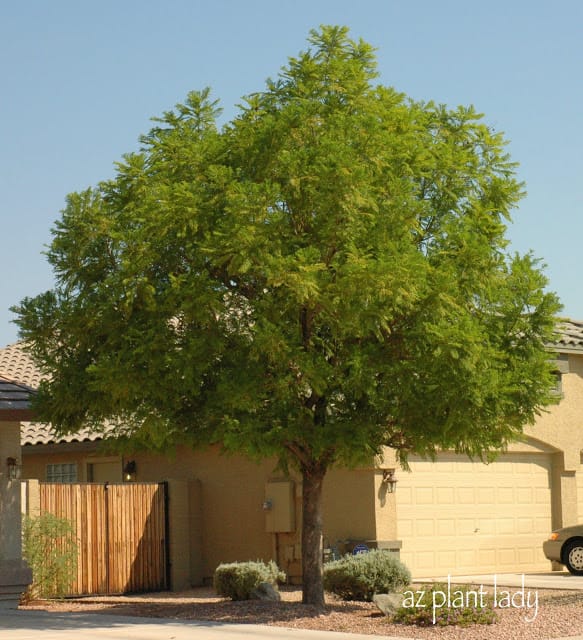
Jacaranda(Jacaranda mimosifilia)
Growing up in Southern California, Jacaranda trees are quite familiar to me. I love their tropical foliage and the flowers are just beautiful. Many transplanted Californians now make their home in Arizona and as a result, like to plant many plants that remind them of home.
Jacaranda trees are actually native to Brazil, but are grown in tropical and semi-tropical regions around the world. In their native, tropical climate, they can exceed heights of 50 ft. x 30 ft. wide. In our semi-tropical, arid climate, they do not grow quite as large as those grown in areas with warmer winters, such as California.
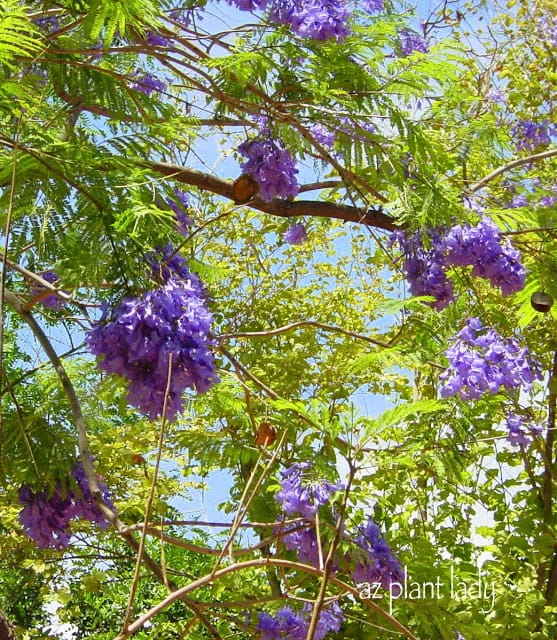
The flowers are just lovely and when they fall, they create a carpet of purple underneath the tree….so don’t rush to rake up the fallen flowers.
In areas with cooler winters, they do lose their leaves. They can also be damaged by hard frosts which sometimes occur in our area, so I would recommend planting in an area that receives some protection from frost.

My parents had a Jacaranda tree in their San Pedro, CA garden and so did my father-in-law in his Scottsdale, AZ garden. As a result, I was able to enjoy their beauty up close. But, I would rather plant a tree that is more tolerant of the occasional hard frosts that my zone 8b garden receives.
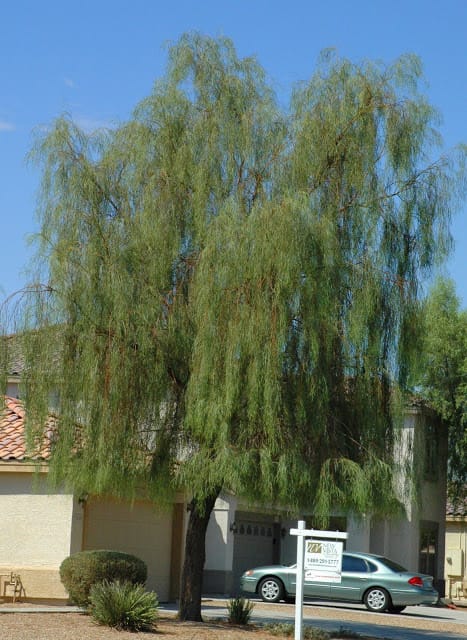
Shoestring Acacia (Acacia stenophylla)
Another import from Australia, Shoestring Acacia makes a wonderful addition to the residential landscape. They are also found growing in parking lots, common areas and golf courses.
This is also a great tree for narrow areas. Evergreen, thornless and long leaves that remind you of shoestrings, hence the common name. At maturity, they can reach heights of 30 ft. high while only reaching 20 ft. wide.
Even if you aren’t a fan of seedpods, these pods look very cool, I think….

These seedpods make great Christmas decorations for the tree….they look like beads strung together. One Christmas, I had a tree solely covered with seedpods from different trees. My mother makes fantastic wreaths out of seedpods. I will probably do a seedpod post soon.
There really nothing negative about Shoestring Acacias, except that they can look somewhat scrawny when they are young. I remember planting them in groups of three around golf courses when the superintendent (my boss) asked me if they would always look so scrawny. I promised him that in 2 years, he would be thanking me for planting them….and he did 😉 Just be patient and you will be rewarded.
Shoestring Acacia is a tree that I may need to consider my garden.

Mesquite (Prosopis species)
Besides Palo Verde trees, Mesquites are probably the second most iconic tree of the desert southwest. You may be surprised to find out that the Mesquite trees found in most landscapes are not the same ones found growing out in the desert, but rather imports from South America.
Mesquite trees are known for growing quickly and providing filtered shade. There are many good reasons to include one in your garden as well as some negatives to be mindful of. The most important consideration for most homeowners is whether the Mesquite they have chosen is a thornless species or not.
First the positives…..beautiful shade tree, moderate to fast growing, thornless varieties available, edible seedpods, flowers attract bees which serve to pollinate other areas of the garden.
Now the negatives…..susceptible to damage from the wind, needs to be staked longer then some other types of trees, thorns (depending on variety), seedpod litter, invasive roots, susceptible to mistletoe infestation, pruning is often required more than once a year.
Here is a list of the most popular Mesquite species and their characteristics:
Argentine Mesquite (Prosopis alba)
20 – 40 ft. high and wide
Thorns
Mostly evergreen
Native to South America
Chilean Mesquite (Prosopis chilensis)
30 ft. high and wide
Some types are thornless
Semi-deciduous (Loses most leaves in winter)
Native to South America
Honey Mesquite (Prosopis glandulosa)
15 – 30 ft. high / 20 – 40 ft. wide
Thorns
Deciduous (loses leaves in winter)
Native to southwestern North America
Velvet Mesquite (Prosopis velutina)
30 ft. high and wide
Thorns
Semi-evergreen
Native to southwestern North America
I love the beauty of Mesquite trees and have grown many both professionally and in my own garden at one time. But for me personally, the maintenance that they require is more than I want to do in my own garden.
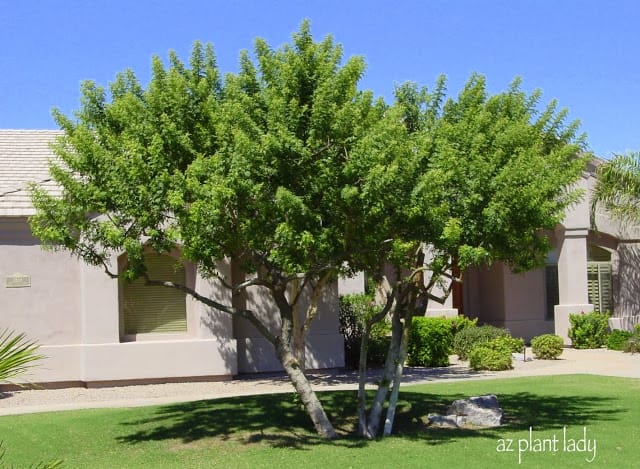
Brazilian Pepper Tree (Schinus teribinthifolius)
This attractive tree has a multitude of uses in the landscape. Brazilian Pepper trees can be found in parks, golf courses, along roadside plantings and residential landscapes. It’s mature size of 15 – 30 ft. high and wide makes it suitable to be used as a patio tree.
In winter, it is evergreen and the female trees produce pretty red clusters of small berries. The fact that it is also thornless makes it a welcome addition to the garden.
Although it is somewhat invasive in humid climates, that is not a problem in arid regions.
I’m not sure about this one for my garden….maybe?
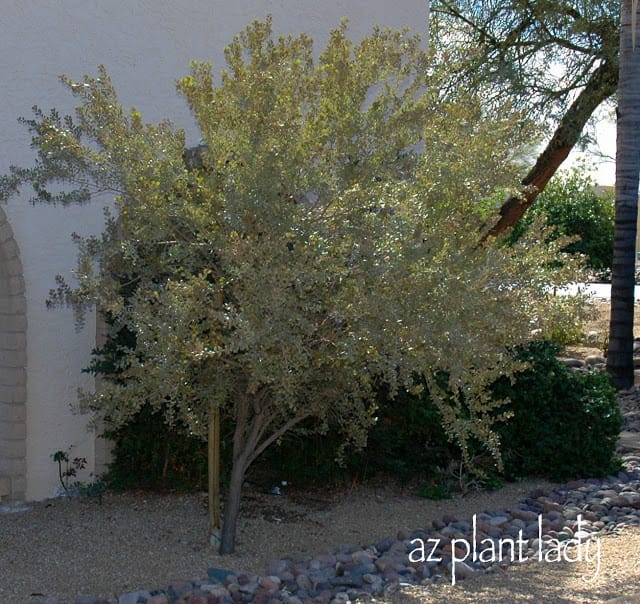
Leatherleaf Acacia (Acacia craspedocarpa)
This small tree can create great contrast in the landscape with it’s gray-green leaves. I find it looks most attractive when planted in groups of 3 or 5, although it would make a great patio tree if planted alone.
Native to Australia, it’s relative small size of 10 – 15 ft. high and wide make it perfect for small areas.
Evergreen, thornless, extremely low-maintenance and interestingly shaped leaves make this tree an asset in the landscape. The leaves are thick and somewhat leathery in texture, hence it’s common name.
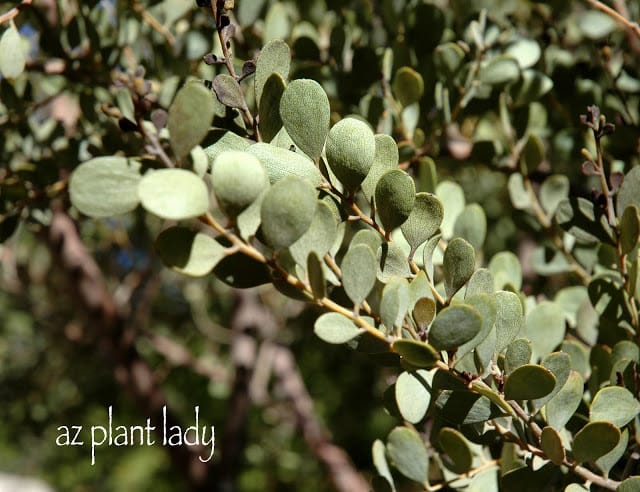
I have not personally grown this tree, but would not hesitate too. But in this case, I am looking for a larger tree.
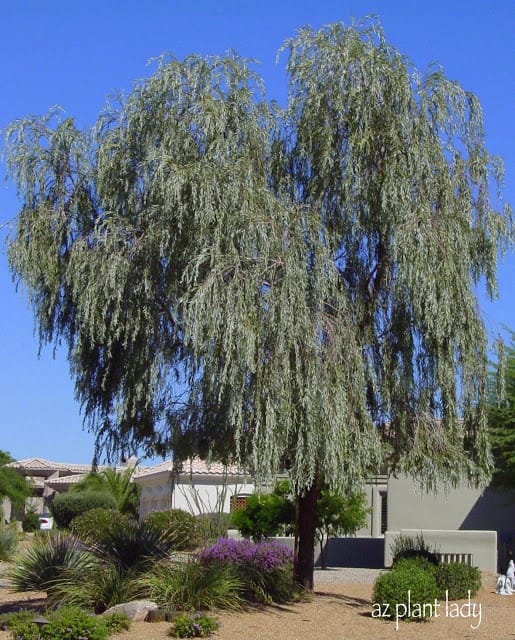
Weeping Acacia (Acacia pendula)
I love the botanical name for this Australian native as it so aptly describes the pendulous branches. I really have a thing for trees that have a weeping type of growth. I’m not sure why.
This tree grows up to 40 ft. high and 25 ft. wide. The light gray-green color also contrasts nicely with darker green foliage in the landscape. The rate of growth is rather slow, so I think I will not add this one to my list.
Well, I wish that I could say that I know exactly what type of tree I am going to plant, but I am honestly not sure. I wrote these posts to help myself as well as those who may be considering some of these trees as well in order to help them with their choice.
I will probably hold off until October or November to make my final decision as they are the best months for planting in our area.
************************
Right now, my vegetable garden is calling to me to come out and plant some seeds.
I hope you are all having a great weekend!








